The Payment Card Industry Data Security Standard (PCI DSS) is a cornerstone of securing payment card transactions and protecting cardholder data. With the release of the new PCI DSS version, organizations must stay updated on the latest requirements to maintain compliance and enhance their security posture. At GM Pacific, we prioritize keeping our clients informed and prepared for these critical changes in IT security and compliance.
Overview of the New PCI DSS Version
The PCI DSS standard undergoes periodic updates to address emerging security threats and technological advancements. The latest version introduces several key changes designed to strengthen the overall security framework and ensure that organizations can effectively safeguard payment card information.
Key Changes in the New PCI DSS Version
1. Enhanced Authentication Requirements
One of the significant updates in the new PCI DSS version is the emphasis on stronger authentication methods. Multi-factor authentication (MFA) is now mandatory for all access to the cardholder data environment (CDE), including internal access by administrators. This change aims to reduce the risk of unauthorized access and enhance overall data security.
2. Updated Encryption Protocols
The new PCI DSS version mandates the use of stronger encryption protocols to protect cardholder data during transmission and storage. Organizations must ensure that they are using the latest encryption standards, such as TLS 1.2 or higher, to mitigate the risk of data breaches and cyberattacks.
3. Expanded Scope of Security Controls
The updated standard expands the scope of security controls to include not only the primary CDE but also any connected systems and devices that could impact the security of cardholder data. This broader scope ensures a more comprehensive approach to securing the payment ecosystem.
4. Regular Risk Assessments
The new version emphasizes the importance of conducting regular risk assessments to identify and address potential vulnerabilities. Organizations are required to perform thorough assessments at least annually and whenever significant changes occur in the environment. This proactive approach helps organizations stay ahead of emerging threats and maintain robust security.
5. Enhanced Logging and Monitoring
To improve incident detection and response, the updated PCI DSS version includes enhanced logging and monitoring requirements. Organizations must implement comprehensive logging mechanisms to track access and activity within the CDE. Additionally, real-time monitoring and alerting systems are essential to promptly identify and respond to potential security incidents.
Steps to Achieve Compliance with the New PCI DSS Version
1. Review and Understand the Changes
The first step in achieving compliance is to thoroughly review and understand the changes introduced in the new PCI DSS version. Organizations should access the official documentation and guidelines provided by the PCI Security Standards Council to gain a comprehensive understanding of the requirements.
2. Conduct a Gap Analysis
Perform a gap analysis to assess your current compliance status against the new requirements. Identify areas where your existing security controls and processes fall short and develop a plan to address these gaps. This analysis will help prioritize remediation efforts and ensure a smooth transition to the new standard.
3. Update Policies and Procedures
Revise your organization’s security policies and procedures to align with the updated PCI DSS requirements. Ensure that all relevant stakeholders are aware of the changes and understand their roles and responsibilities in maintaining compliance.
4. Implement Necessary Security Controls
Based on the gap analysis, implement the necessary security controls to meet the new requirements. This may involve upgrading encryption protocols, deploying MFA solutions, enhancing logging and monitoring systems, and conducting regular risk assessments.
5. Train and Educate Employees
Employee awareness and training are crucial for maintaining PCI DSS compliance. Provide comprehensive training sessions to educate employees about the new requirements and best practices for protecting cardholder data. Regular training helps foster a security-conscious culture within the organization.
6. Engage with Qualified Security Assessors (QSAs)
Consider engaging with Qualified Security Assessors (QSAs) to conduct an independent assessment of your compliance status. QSAs can provide valuable insights and recommendations to help you achieve and maintain compliance with the new PCI DSS version.
Conclusion
The new PCI DSS version brings important updates that enhance the security of payment card transactions and protect cardholder data. By understanding and implementing these changes, organizations can ensure robust security and maintain compliance with industry standards. At GM Pacific, we are committed to helping our clients navigate these updates and achieve excellence in IT security and compliance.
For more information on how GM Pacific can assist with PCI DSS compliance and other IT security solutions, contact us today.
